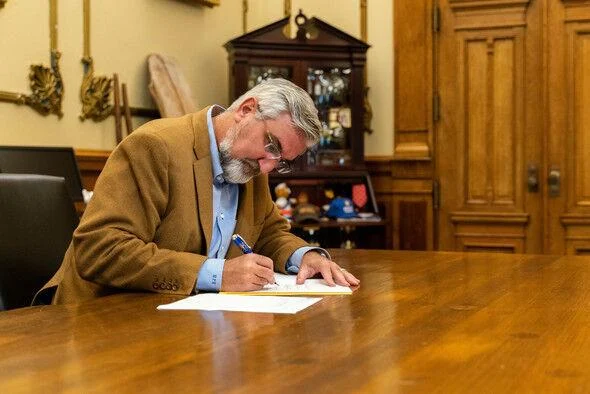79 new bills hit the governor’s desk to await his signature
- By Ashlyn Myers, TheStatehouseFile.com
INDIANAPOLIS—After having only 14 bills to sign to this point in the legislative session, Gov. Eric Holcomb’s to-do list is stacked high as 79 new bills hit his desk.
How do bills make it onto Holcomb’s desk?
Bills are created by lawmakers, then must pass their respective chamber. After this, they go to the opposing chamber.

For example, if a representative created a bill in the House and it passed through committee meetings, it would then go on to what’s called a second reading, during which every representative has the opportunity to ‘amend’ or potentially change the bill. During this time, lawmakers argue about different, specific parts of a bill, and sometimes new language is added. In some cases, no amendments are introduced and the bill immediately moves to its third reading.
A bill’s third reading is when lawmakers argue about a bill in its entirety and new changes generally are not introduced. If a bill manages to get enough votes, it moves to the other chamber to repeat the same process. After this, if the bill is not amended in the second chamber and is passed, it fast-tracks right to the governor.
However, if a bill faces amendments and both chambers cannot agree on the changes made, the bill goes to a conference committee, where two lawmakers from each chamber and party try to reconcile the differences, deciding on a version of the bill that is agreeable to everyone.
In the event that legislators come to an agreement and pass the compromise version in both chambers, their newly updated bill heads to the governor. If they cannot agree, the bill dies.
How long does Holcomb have to decide?Â
After a bill hits the governor’s desk, he has seven days to decide what he wants to do with it. He can either sign it into law, veto the bill, which just means he would override the House and Senate’s vote to pass it, or not sign it at all. Typically, Holcomb always signs or vetoes the bills.
How many has he signed so far?
So far, Holcomb has signed 14 bills into law, covering topics like utilities, corrections and the Indiana National Guard. The only bill to receive significant attention so far has been Senate Bill 480, which bans gender transition health-care procedures for minors.
What kinds of bills are on his desk now?
Holcomb’s stack of bills covers all kinds of things, like legalizing throwing stars and requiring additional fees for purchasing a fishing license.
There is also House Bill 1169, which would require the Indiana Department of Child Services to consider the best interests of a child if they and their sibling are at risk of being separated in the foster-care system.
Or House Bill 1341, which would require that after June 30, 2024, fire departments cannot purchase any fire gear containing PFAS chemicals, which are long-lasting chemicals that have been closely linked with cancer in firefighters. According to the CDC, cancer is the leading cause of death in firefighters due to smoke inhalation and contaminated fire gear.
Newcomer Rep. Kendell Culp, R-Rensselaer, has one of his first bills, House Bill 1557, on Holcomb’s desk as well. If passed, it would direct the Indiana Department of Agriculture to conduct an inventory of lost farmland.
This newest batch of bills comes with a deadline of April 25.
2023 bills by the numbers
-
Holcomb has vetoed zero bills this session, compared to two last year on transgender rights and technology.
-
This year, the House started with 673 bills and the Senate started with 489.
-
Last year, the House filed 418 bills and the Senate filed 441.
Ashlyn Myers is a reporter for TheStatehouseFile.com, a news website powered by Franklin College journalism students.





